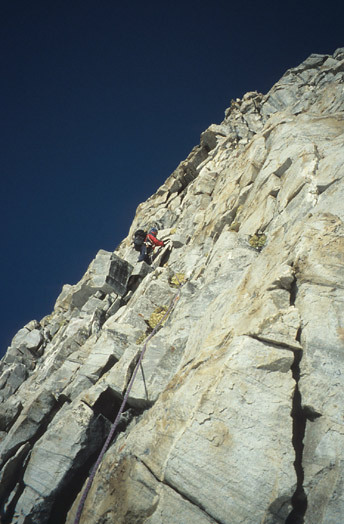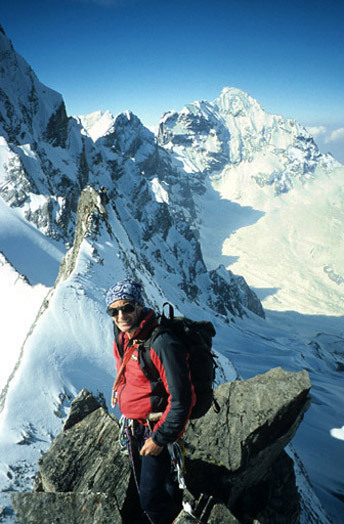
Mick Cottam leading the first pitch on the east face of the summit block of Danesh Parvat (5490m) in India’s Kagbhusandi valley, Central Garhwal. The block gave two full pitches of steep granite climbing with sections of 5.7/8. [Photo] Dave Wynne-Jones
To mark the 150th anniversary of the inaugeration of the Alpine Club, well known Himalayan explorer Harish Kapadia (who is an honorary member) organized a joint Indo-British expedition to the Kagbhusandi valley in India’s Central Garhwal. This valley lies south of the Bhuidhar, a.k.a. Valley of Flowers, and should not be confused with the location of Kagbhusand (5830m), a peak much further north toward Kamet (7756m) that was climbed by Eric Shipton in 1931. Kapadia had visited the Kagbhusandi in May 2006, when he planned to trek to the head and then cross the Kankul Khal (pass) towards the Dhauli Ganga river and Joshimath. Unfortunately, he was turned back by unexpectedly deep snow. He hoped to rectify this in 2007 by going later (late May, finishing in mid June). With him were Atul Rawal and four members of the AC: Chris Astill, Mick Cottam, Mark Higton and Dave Wynne-Jones. The last four may be the first non Indians to climb in this valley.
Starting up the popular trek toward the Valley of Flowers, the team took three days to reach a base camp at Chhaiyan Kharak (3815m). To the north towered Hathi Parbat (6,727m) and the lower Otika Danda (5780m), the only peaks so far climbed in this valley. Hathi Parbat was climbed in 1963 by a team from the Indo-Tibet Border Police and two years later one of the summiteers, HCS Rawat, became the first Indian to stand on the summit of Everest. On the first day of the approach to base camp, the climbers had a timely reminder of Alpine and Himalayan Club links when, by chance, they met Nanda Sinh Chauhan. Now 94 years old, he was with Frank Smythe in both 1931 and 1937, when they made the historic visit to the Valley of Flowers.
Despite the later timing, the expedition found difficult snow conditions and, once again, Kapadia was unable to cross the pass, as the snow was too deep for laden porters. However, the British contingent, which had a permit to climb up to 6000 meters, made three first ascents. Peak AC 150 (5030m) lay immediately west of the 4665-meter (GPS) Kankul Khal. All four climbers approached via the northeast flank. In the upper section Astill and Cottam climbed a couloir east of the north ridge, while Higton and Wynne-Jones took the crest direct in four pitches of Scottish 3. Four more pitches of mixed ground and a narrow snow ridge led to the summit. The overall grade was AD.
Cottam and Wynne-Jones then climbed the already named but previously virgin Danesh Parvat (5490m). The pair attempted the west ridge and followed the ever steepening and narrowing crest to the sheer summit block. After two hours probing snow-covered cracks and a chimney full of unstable blocks, they retreated, only to see during their descent a narrow snow ramp rising below the overhanging north face of the summit. They climbed back up and across two pitches of doubtful snow to the east face, where two more pitches in vertical granite cracks (sections of 5.7/5.8) led to the top. The grade was estimated to be D.

Mick Cottam on the summit of Danesh Parvat after the successful first ascent via the west ridge, north face and east face (D, snow, ice and mixed with 5.7/5.8 on the summit block, Cottam and Wynne-Jones, 2007). [Photo] Dave Wynne-Jones
The following day Astill and Higton reached the summit of Pt. 5080m (map reading; the GPS was lower), which lies east of the pass and has been named Kankul Peak. The pair climbed a couloir running parallel to, and a little below, the north ridge (AD).
A little to the west, a Himalayan Club expedition from Calcutta, led by Apurba Kr. Bhattacharyya, became the first Indian civilians to climb the famous Nilkanth (6,596m), when they made the fifth ascent via the west ridge. Eleven members, including four climbing Sherpas, reached the summit on June 11 after having fixed 2000m of rope. This peak has seen more than 20 attempts and a number of fatalities. It was first climbed from the north in 1974 by the ITBP after many attempts. A large multi-national military expedition climbed the northeast ridge in 1993, while the west ridge was first climbed in 2000 by five members of a primarily-British, guided expedition led by Martin Moran. They fixed 200m of rope low on the route but afterwards climbed in alpine style and rated the ascent D+/TD-. The following year Matic Jost and Marko Prezelj made the first true alpine style ascent of the peak when they climbed the west ridge, up and down, in three days. Under the conditions prevailing at the time they found the climbing demanding and felt a grade of TD more appropriate. Despite the use of huge amounts of fixed rope, this would appear to be a significant technical ascent by Indian civilian mountaineers.